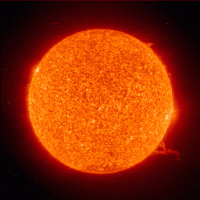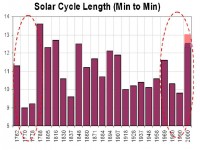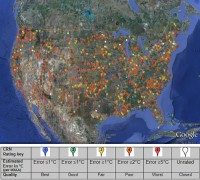May 28, 2009
New Solar Cycle Prediction: Fewer Sunspots, But Not Necessarily Less Activity
May 27th, 2009 By Tony Phillips
An international panel of experts has released a new prediction for the next solar cycle, stating that Solar Cycle 24 will peak in May 2013 with a below-average number of sunspots. Led by the National Oceanic and Atmospheric Administration (NOAA) and sponsored by NASA, the panel includes a dozen members from nine different government and academic institutions. Their forecast sets the stage for at least another year of mostly quiet conditions before solar activity resumes in earnest.

“If our prediction is correct, Solar Cycle 24 will have a peak sunspot number of 90, the lowest of any cycle since 1928 when Solar Cycle 16 peaked at 78,” says panel chairman Doug Biesecker of the NOAA Space Weather Prediction Center, Boulder, Colo.
It is tempting to describe such a cycle as “weak” or “mild,” but that could give the wrong impression. “Even a below-average cycle is capable of producing severe space weather,” says Biesecker. “The great geomagnetic storm of 1859, for instance, occurred during a solar cycle of about the same size we’re predicting for 2013.”

This plot of sunspot numbers shows the measured peak of the last solar cycle (Solar Cycle 23) in blue and the predicted peak of the next solar cycle (24) in red. Credit: NOAA/Space Weather Prediction Center.
The 1859 storm—named the “Carrington Event” after astronomer Richard Carrington who witnessed the instigating solar flare—electrified transmission cables, set fires in telegraph offices, and produced Northern Lights so bright that people could read newspapers by their red and green glow. A recent report by the National Academy of Sciences found that if a similar storm occurred today, it could cause $1 to 2 trillion in damages to society’s high-tech infrastructure and require four to ten years for complete recovery. For comparison, Hurricane Katrina caused $80 to 125 billion in damage.
The latest forecast revises a prediction issued in 2007, when a sharply divided panel believed solar minimum would come in March 2008 and would be followed by either a strong solar maximum in 2011 or a weak solar maximum in 2012. Competing models of the solar cycle produced different forecasts, and researchers were eager for the sun to reveal which was correct.
“It turns out that none of the models were really correct,” says Dean Pesnell of the Goddard Space Flight Center, Greenbelt, Md. NASA’s lead representative on the panel. “The sun is behaving in an unexpected and very interesting way.” Read story here.
Icecap Note: Other forecasters (Clilverd and Archibald) have an even quieter cycle like that of the s0-called Dalton Minimum with a maximum nearer 40. NCAR’s Dikpati is still holding out for an active cycle 24. The last few cycles including this ultralong cycle 23 (larger image here) mimics the cycles of the late 1700s and early 1800s much as Clilverd and Archibald showed, leading up to the Dalton Minimum, the age of Dickens with winter snows in London (hmmm).

May 26, 2009
No scientific “consensus” about “global warming”
By Bob Ferguson and Lord Christopher Monckton, SPPI
WASHINGTON--(BUSINESS WIRE)—The Science and Public Policy Institute (SPPI) in Washington reports that a leading expert on climate and former advisor to Margaret Thatcher as UK Prime Minister, has dismissed as false a recent claim by the Washington Post that “most scientists now say there is a consensus about climate change”; that warming is “unequivocal”; and that most of the warming of the past century was manmade.
Christopher Monckton, in a new paper for SPPI entitled Unequivocal ‘Consensus’ on ‘Global Warming’, says:
“There is ... no sound or scientific basis for the notion, peddled by the Washington Post, that there is a scientific ‘consensus’ to the effect that anthropogenic ‘global warming’ has occurred, is occurring, will occur, or, even if eventually it does occur, will be significant enough to be dangerous.”
The SPPI paper reveals the following facts that are usually overlooked or ignored -
>Science is not done by “consensus”: the argument from consensus is an instance of the Aristotelian logical fallacy known as the “head-count” fallacy.
>The decision by the UN’s climate panel to attribute more than half of the past 50 years’ warming to humankind was taken by an unscientific show of hands.
>The UN’s chapter attributing most of the past half century’s warming to humankind was rejected by most of the UN’s own official reviewers.
>The warming rate from 1975-1998, when humankind might have had some influence, was the same as the rate from 1860-1880 and from 1910-1940, when humankind’s influence was negligible.
>There is no anthropogenic signal at all in the global temperature record.
>For 15 years there has been no statistically-significant “global warming”.
>For 7.5 years there has been rapid but largely-unreported global cooling.
>The greatest warming rate in the past 300 years was from 1645 to 1715, before the Industrial Revolution began. That warming rate was eight times the 20th-century warming rate.
>The warming of the past 300 years is indeed unequivocal, but the mere fact of the warming tells us nothing of its cause. There is no scientific basis for attributing most of it to humankind.
>The notion that “2,500 scientists” personally agreed with the 2007 assessment report of the UNís climate panel is nonsense.
>The largest-ever survey of scientific opinion - the largest to date - found more than 31,000 scientists did not consider the human contribution to “global warming” significant enough to be dangerous.
>Much of the UN’s reports are written by environmental campaigners, not scientists.
Robert Ferguson, SPPI’s president, said: “In a May 19 article by David Fahrenthold, yet again the Washington Post has been caught out publishing false science, selective data, and faulty conclusions. It is time that certain sections of the news media realized that, as every opinion poll shows, fewer and fewer of the public are any longer believing the politically-driven nonsense they write about ‘global warming’”.
Asks Ferguson, “Has the Washington Post resurrected former Post reporter Janet Cook? Instead of fabricating an 8-year-old heroin addict, has Fahrenthold fabricated a “consensus” about global warming science? Like Cook’s story, the Post’s report proves bereft of evidence and reality. On April 17, 1981, shortly after Cook and the Post were exposed, the New York Times editorialized, ‘When a reputable newspaper lies, it poisons the community; every newspaper story becomes suspect.’ We could not have said it better. Even more tragically, these climate fantasies put at risk the economies and liberties of the Western World and the lives of many in the Third World. Where is the accountability?” See story here.
May 22, 2009
The Green Bubble
By Ted Nordhaus and Michael Shellenberger
Sometime after the release of An Inconvenient Truth in 2006, environmentalism crossed from political movement to cultural moment. Fortune 500 companies pledged to go carbon neutral. Seemingly every magazine in the country, including Sports Illustrated, released a special green issue. Paris dimmed the lights on the Eiffel Tower. Solar investments became hot, even for oil companies. Evangelical ministers preached the gospel of “creation care.” Even archconservative Newt Gingrich published a book demanding action on global warming.
Green had moved beyond politics. Gestures that were once mundane--bringing your own grocery bags to the store, shopping for secondhand clothes, taking the subway--were suddenly infused with grand significance. Actions like screwing in light bulbs, inflating tires, and weatherizing windows gained fresh urgency. A new generation of urban hipsters, led by Colin Beavan, a charismatic writer in Manhattan who had branded himself “No Impact Man,” proselytized the virtues of downscaling--dumpster-diving, thrift-store shopping, and trading in one’s beater car for a beater bike--while suburban matrons proudly clutched copies of Michael Pollan’s In Defense of Food and came to see the purchase of each $4 heirloom tomato at the farmer’s market as an act of virtue.
For those caught up in the moment, the future seemed to promise both apocalypse and transcendence in roughly equal measure. The New York Times and San Francisco magazine ran long feature stories on the uptick of upper-middle- class professionals who worried to their therapists about polar bears or who dug through the trash cans of co-workers to recycle plastic bottles, as though suffering from a kind of eco-OCD. At the same time, folks like Pollan and Beavan provided a vision of green living that seemed to offer not just a smaller carbon footprint but a better life. Amid the fear was the hope that the ecological crisis would bring us together and make us happier.
And then, almost as quickly as it had inflated, the green bubble burst. Between January 2008 and January 2009, the percentage of Americans who told the Pew Research Center for the People and the Press that the environment was a “top priority” dropped from 56 percent to 41 percent. While surveys have long showed that enthusiasm for all things green is greatest among well-educated liberals, the new polling results were sobering. For the first time in a quarter century, more Americans told Gallup in March that they would prioritize economic growth “even if the environment suffers to some extent” than said they would prioritize environmental protection “even at the risk of curbing economic growth.” Soon thereafter, Shell announced it would halt its investments in solar and wind power.
Of course, environmentalism itself has not disappeared. Earth Day was celebrated last week, magazines and marketers continue to use green to sell to upscale audiences, and legislation to cap carbon emissions, albeit heavily watered-down, could still pass Congress. But the cultural moment marked by the ubiquity of green self-help, apocalypse talk, and cheery utopianism has passed. It is tempting to reduce this retrenchment to economic pressures alone, with concrete short-term concerns trumping more abstract worries about the future. But a closer look at the causes of the green bubble reveals a more complicated story, not just about the nature of environmentalism but about modern American life itself.
Green anti-modernism brings with it other contradictions. Despite the rhetoric about “one planet,” not all humans have the same interests when it comes to addressing global warming. Greens often note that the changing global climate will have the greatest impact on the world’s poor; they neglect to mention that the poor also have the most to gain from development fueled by cheap fossil fuels like coal. For the poor, the climate is already dangerous. They are already subject to the droughts, floods, hurricanes, and diseases that future warming will intensify. It is their poverty, not rising carbon-dioxide levels, that make them more vulnerable than the rest of us. By contrast, it is the richest humans--those of us who have achieved comfort, prosperity, and economic security for ourselves and for our children--who have the most to lose from the kind of apocalyptic global-warming scenarios that have so often been invoked in recent years. The existential threat so many of us fear is that we might all end up in a kind of global Somalia characterized by failed states, resource scarcity, and chaos. It is more than a little ironic that at the heart of the anti-modern green discourse resides the fear of losing our modernity.
Nonetheless, it has become an article of faith among many greens that the global poor are happier with less and must be shielded from the horrors of overconsumption and economic development--never mind the realities of infant mortality, treatable disease, short life expectancies, and grinding agrarian poverty. The convenient and ancient view among elites that the poor are actually spiritually rich, and the exaggeration of insignificant gestures like recycling and buying new lightbulbs, are both motivated by the cognitive dissonance created by simultaneously believing that not all seven billion humans on earth can “live like we live” and, consciously or unconsciously, knowing that we are unwilling to give up our high standard of living. This is the split “between what you think and what you do” to which Pollan refers, and it should, perhaps, come as no surprise that so many educated liberals, living at the upper end of a social hierarchy that was becoming ever more stratified, should find the remedies that Pollan and Beavan offer so compelling. But, while planting a backyard garden may help heal the eco-anxieties of affluent greens, it will do little to heal the planet or resolve the larger social contradictions that it purports to address. Read much more of this insightful look into the Green Bubble.
May 22, 2009
“Is The U.S. Surface Temperature Record Reliable?”
By Anthony Watts on Climate Science
Anthony Watts, author of the weblog Watts Up With That, has completed an outstanding, clearly written report that documents a major problem with the use of the United States Historical Climatology Network (USHCN) to assess multi-decadal surface temperature trends. The report is “Watts, A. 2009: Is the U.S. Surface Temperature Record Reliable? 28 pages, March 2009 The Heartland Institute.
The Executive Summary reads:
“Global warming is one of the most serious issues of our times. Some experts claim the rise in temperature during the past century was “unprecedented” and proof that immediate action to reduce human greenhouse gas emissions must begin. Other experts say the warming was very modest and the case for action has yet to be made. The reliability of data used to document temperature trends is of great importance in this debate. We can’t know for sure if global warming is a problem if we can’t trust the data.
The official record of temperatures in the continental United States comes from a network of 1,221 climate-monitoring stations overseen by the National Weather Service, a department of the National Oceanic and Atmospheric Administration (NOAA). Until now, no one had ever conducted a comprehensive review of the quality of the measurement environment of those stations.
During the past few years I recruited a team of more than 650 volunteers to visually inspect and photographically document more than 860 of these temperature stations. We were shocked by what we found. We found stations located next to the exhaust fans of air conditioning units, surrounded by asphalt parking lots and roads, on blistering-hot rooftops, and near sidewalks and buildings that absorb and radiate heat. We found 68 stations located at wastewater treatment plants, where the process of waste digestion causes temperatures to be higher than in surrounding areas.
In fact, we found that 89 percent of the stations - nearly 9 of every 10 - fail to meet the National Weather Service’s own siting requirements that stations must be 30 meters (about 100 feet) or more away from an artificial heating or radiating/reflecting heat source. In other words, 9 of every 10 stations are likely reporting higher or rising temperatures because they are badly sited.

Larger image here. Lampasas Texas shown as an example.

It gets worse. We observed that changes in the technology of temperature stations over time also has caused them to report a false warming trend. We found major gaps in the data record that were filled in with data from nearby sites, a practice that propagates and compounds errors. We found that adjustments to the data by both NOAA and another government agency, NASA, cause recent temperatures to look even higher.
The conclusion is inescapable: The U.S. temperature record is unreliable. The errors in the record exceed by a wide margin the purported rise in temperature of 0.7C (about 1.2F) during the twentieth century. Consequently, this record should not be cited as evidence of any trend in temperature that may have occurred across the U.S. during the past century. Since the U.S. record is thought to be “the best in the world,” it follows that the global database is likely similarly compromised and unreliable.
This report presents actual photos of more than 100 temperature stations in the U.S., many of them demonstrating vividly the siting issues we found to be rampant in the network. Photographs of all 865 stations that have been surveyed so far can be found here , where station photos can be browsed by state or searched for by name.”
This is a report that is very much worth reading! Hardcopies are available for purchase from The Heartland Institute 19 South LaSalle Street #903 Chicago Illinois 60603.
May 21, 2009
Meaningless, Unfunded Climate Plans Forge Ahead - This is How Climate Research Works Too
By Paul Chesser, globalwarming.org
With the EPA and Congress barreling towards greenhouse gas regulation, you might think that all the states and local governments putting together their own plans might declare victory and move on to more pressing matters like creating make-work with federal stimulus money. You’d be wrong.
The Almanac newspaper reports today that the Menlo Park (Calif.) City Council earlier this week approved a climate action plan created by its volunteer Green Ribbon Citizens’ Committee. As with TARP, however, it appears local leaders may only be willing to go as far as tax-grabbers from larger jurisdictions will pay for them to go:

The City Council approved the plan in a unanimous vote at its May 19 meeting. Prepared by a consultant that specializes in creating climate strategies for local jurisdictions and revised by city staff members, the plan expands upon and fleshes out a dense list of recommendations prepared by the volunteer Green Ribbon Citizens’ Committee in late 2007, council members say.
They acknowledge, however, that (the plan is) incomplete. The city exhausted the $38,000 it expects to receive in grant money to prepare the plan before it had a chance to fully revise the document, and council members look poised to allow a city commission to work on the plan - possibly in consultation with the Green Ribbon committee.
Undoubtedly it was the “consultant” who exhausted the $38k (which the city doesn’t even have yet!). Pretty good gig when these eco-consultants can drop their “climate plan” template on a municipality and collect a cool five-figure (plus?) sum for filling in the blanks. By the way, local watchbloggers, you might check how these consultants are working, lobbying, and wining and dining city officials to get these deals. Back to The Almanac:
Much of the discussion at the May 19 meeting centered on how the city could quantify its efforts to rein in the amount of greenhouse gases emitted into the Earth’s atmosphere. In an impassioned speech to the council, Mitch Slomiak, head of the Green Ribbon committee, urged the city to set measurable goals in reducing emissions, and to treat its “carbon budget” in the same way it regards its general operating fund budget. You know, like their personal slush fund and favor factory. Like Waxman-Markey.
But council members struggled with how to make the issue tangible. Easy - make it as tangible as CO2! Unlike most of the line items in the city’s budget, a decreased carbon output won’t provide a direct benefit to the city. Hmm - truly a dilemma for politicians who expect something in exchange for wasting their constituents’ money.
“One might almost conclude that anything we do here is basically symbolic, and setting an example,” said Councilman Andy Cohen. Money quote: About as close as you’ll get to hearing a global warming alarmist politician saying their climate plans are meaningless.
Councilman John Boyle said he was struggling with the idea of how the plan would fit in with the city’s budget. He noted that even actions that would pay for themselves, such as installing solar panels on city buildings, often take decades to recoup their costs.
But you’re forgetting all the green jobs!
The plan leaves much to be desired, but council members say that approving it is an important gesture - and that its existence may help the city in competing for grants, especially through the federal stimulus bill. Aha, the real motive - meaningless gestures paid for by (not yet issued) grants, so you can get more grants! Read more here.
|








